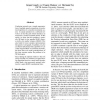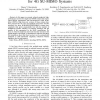159 search results - page 16 / 32 » Fast Decoding and Optimal Decoding for Machine Translation |
EMNLP
2008
13 years 8 months ago
2008
Confusion networks are a simple representation of multiple speech recognition or translation hypotheses in a machine translation system. A typical operation on a confusion network...
EMNLP
2011
12 years 7 months ago
2011
State of the art Tree Structures Prediction techniques rely on bottom-up decoding. These approaches allow the use of context-free features and bottom-up features. We discuss the l...
VTC
2008
IEEE
14 years 1 months ago
2008
IEEE
Abstract—In this paper we present reduced-complexity highperformance receivers for single-user MIMO systems that employ coded OFDM transmission with bit-interleaved coded modulat...
TAL
2010
Springer
13 years 5 months ago
2010
Springer
Abstract. We describe OpenMaTrEx, a free/open-source examplebased machine translation (EBMT) system based on the marker hypothesis, comprising a marker-driven chunker, a collection...
EMNLP
2009
13 years 5 months ago
2009
Binarization of Synchronous Context Free Grammars (SCFG) is essential for achieving polynomial time complexity of decoding for SCFG parsing based machine translation systems. In t...


